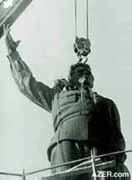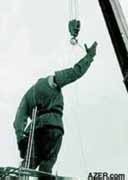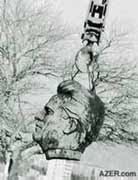|

Summer 2001 (9.2)
Pages
40-42
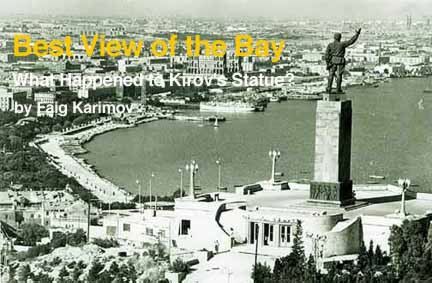
High
up on the crest of Baku's highest hill there used to stand a
tall imposing statue of Sergey Kirov. One of the most influential
Bolshevik leaders, Kirov was responsible for leading the Red
Army to capture Baku in 1920 and establish a Soviet government.
The statue no longer stands today, as it was dismantled shortly
after Azerbaijan gained its independence nearly a decade ago.
Today if you go to the site, which provides a spectacular view
overlooking Baku and the bay, there's not even a trace of the
statue's pedestal that once featured scenes of workers extracting
oil.
Sergey Mironovich Kirov (his real last name was Kostrikov) (1886-1934)
was born in Urzhum, Russia. He came to the Caucasus in 1910 to
work as a Communist Party organizer.
Eventually, he helped organize the Red Army's entry into the
Caucasus; they drove out the White Guards in 1920 and subsequently
set up three socialist republics in the region-Armenia, Georgia
and Azerbaijan. In Azerbaijan, this meant that the fledgling
government, Azerbaijan's first experiment with independence -
the Azerbaijan Democratic Republic - was squelched after only
23 months (1918-1920). When the Bolsheviks took over, the majority
of oil entrepreneurs fled the country. Those who remained lost
their lives and their families were exiled to Central Asia.
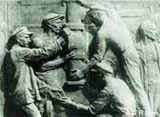 |
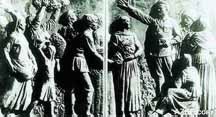 |
Above: The Kirov statue's pedestal
once featured scenes of Azerbaijani workers extracting oil and
harvesting grapes for wine. Photos: National Archives.
In 1921 Kirov was appointed by Lenin and the Politburo to be
the Secretary of the Communist Party of Azerbaijan. They were
especially concerned about the oil industry that was faltering,
as previously it had consisted of 250 privately owned enterprises
before it was consolidated under Soviet control.
Kirov played an important role in helping to deliver Baku's oil
to Soviet Russia. Although he assumed that his assignment in
Baku would last a few short months, he remained four and a half
years. Kirov's wife, Maria Lvovna, is said to have taken quite
an active role in the social and educational development at the
time by organizing a woman's society, the goal of which was to
free women from having to wear the veil and whose slogan was
"Down with the Chador".
In 1926, Kirov was transferred to Leningrad to replace one of
Stalin's chief rivals, Gregory Zinovyev. In 1930, because of
his unwavering support for Stalin, Kirov became a full member
of the Politburo, the highest decision-making body in the Soviet
Union.
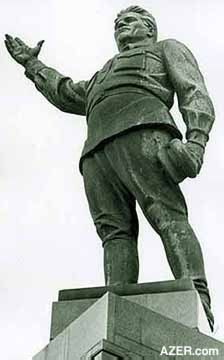  Mysterious murder Mysterious murder
But his rise to power was short-lived. On December 1, 1934, Kirov
was assassinated. A young Party member named Leonid Nikolayev
shot Kirov point-blank in the hallway of the Communist Party
headquarters in Leningrad.
Nikolayev and 13 suspected accomplices were immediately arrested,
accused of terrorism and shot. However, the circumstances surrounding
Kirov's murder were rather murky. The official story was that
terrorists - enemies of Socialism - had killed Kirov. But people
who knew the situation best had their doubts.
However, the assassination gave Stalin an excuse to start the
Great Purge of 1934-38 when anyone critical of the State (and
even many who were not) were arrested, imprisoned, sent into
exile to work in labor camps or shot to death. Hundreds of thousands
of people throughout the Soviet Union, many of thom intellectuals,
writers, scientists, educators, students and medical professionals,
were silenced by Stalin's repressions. [See the account by Ismikhan
Rahimov, "To
Siberia and Back, Life as Political Prisoner SH-971"
in AI 7.3,
Autumn 1999.]
Today, in Azerbaijan,
as elsewhere in the former Soviet Union, its not hard to find
many who can still recall firsthand the nightmare of those early
morning arrests when family members, relatives or friends were
banished, never to be seen again. [See Anar's "The
Morning of That Night", AI 7.1, Spring 1999.]
Even though Stalin claimed that he had uncovered a conspiracy
to overthrow Communist leaders, he is the one who most suspect
of having ordered Kirov's murder in the first place. In 1934
Kirov had collected more votes than Stalin in the election for
Secretary of the Communist Party. At the time, Kirov had refused
to replace Stalin in this post, saying that the residents of
Leningrad needed him to remain there. But perhaps Kirov's gesture
was not enough to pacify Stalin.
Evidence of the plot to murder Kirov would seem to point the
finger at Stalin. [See the book, "Who Killed Kirov? The
Kremlin's Greatest Mystery" by Amy Knight. New York: Hill
and Wang, 1999.]
In any case, Kirov's assasination made him a martyr for the Communist
cause. In Azerbaijan, Soviet authorities credited Kirov for rescuing
Azerbaijan from difficulties and working hard for its development.
But, in fact, he had masterminded the destruction of the fledgling
government of Azerbaijan's Democratic Republic (1918-1920) and
had executed those who had sought Azerbaijan's independence and
resisted the Bolsheviks.
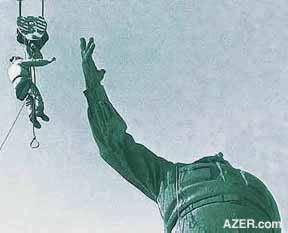  Left and below: Once the Soviet Union collapsed in December
1991 and Azerbaijan gained its independence, the Kirov statue
and other monuments honoring heroes of the Soviet regime such
as Lenin, were promptly dismantled. Photos: Rauf Umud. Monuments
to Stalin had already been dismantled after his death Left and below: Once the Soviet Union collapsed in December
1991 and Azerbaijan gained its independence, the Kirov statue
and other monuments honoring heroes of the Soviet regime such
as Lenin, were promptly dismantled. Photos: Rauf Umud. Monuments
to Stalin had already been dismantled after his death
in 1953.
For
children of the Soviet period, Kirov was touted as one of their
greatest heroes. They were taught that "Kirov was a close
friend of the leader of the Soviet Communist Party, that he had
been Lenin's associate and had worked together with him to free
the poor from the oppression of the rich." He was said to
have been brave and courageous, never afraid of anything and
ready to sacrifice his life for the sake of the poor. And naturally,
schoolchildren believed all this, since it was written in their
textbooks.
In 1939, a huge statue of Kirov in granite and bronze was erected
in Baku's Dagustu (Highland) Park. Pinkhos Sabsay was the sculptor
and L. Ilyin, the architect. Many dignitaries took part in the
opening ceremony, including Mirjafar Baghirov, Azerbaijan's Communist
Party Secretary at the time. In his speech, Baghirov praised
Kirov as a great hero of Azerbaijan. The statue depicted Kirov
as a strong leader, dressed in his army uniform, with his right
arm raised as if pointing the way for the troops or, perhaps,
it was anticipating the future - the stylized pose used for so
many statues of the Soviet period, starting with Lenin.
Other memorials were set up as well. For example, the ancient
city of Ganja, which has roots back to the 5th or 6th century,
was renamed Kirovabad in 1935, a name it retained until Azerbaijan
gained its independence in 1991. A Home Museum for Kirov was
opened in 1938. Today, it is closed.
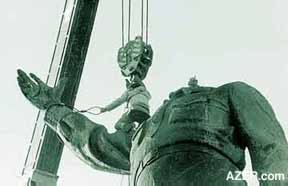  Kirov's statue was erected
at the top of the hill area that had served as a cemetery to
the victims slaughtered by a movement led by Bolsheviks and Armenians
in 1918, when thousands of Azerbaijanis were killed. The Communist
leaders are believed to have erected the prominent statue of
Kirov to erase the people's memory of the evidence of brutal
events that had occurred little more than two decades earlier. Kirov's statue was erected
at the top of the hill area that had served as a cemetery to
the victims slaughtered by a movement led by Bolsheviks and Armenians
in 1918, when thousands of Azerbaijanis were killed. The Communist
leaders are believed to have erected the prominent statue of
Kirov to erase the people's memory of the evidence of brutal
events that had occurred little more than two decades earlier.
During the Soviet period, Dagustu Park (Highland Park) became
a popular entertainment spot for families, as it was developed
into an attractive city park. In the evening, Baku residents
enjoyed the park with their children.
From time to time, concerts were held there, and every year on
May 9, known as Victory Day (referring to the Soviet Union's
victory in World War II), from that high vantage point, residents
viewed the fireworks that were set off over the Caspian.
After the Black January massacre of January 20, 1990, the victims
were buried on the hill, which became known as Shahidlar Khiyabani
(Martyrs' Lane), and the wooded hillside gained back its earlier
honor of serving as a commemorative graveyard once again. Since
then, some of the victims of the Nagorno-Karabakh war have also
been buried there. Today Azerbaijanis, families, relatives and
friends visit the site to show their respect for the memories
of those who sacrificed their lives for the sake of Azerbaijan.
Foreign dignitaries also pay homage to the site; the most recent
prominent visitors included Russia's President, Vladimir Putin,
on January 9, 2001.
Dismantling the
Statue
And whatever happened to Kirov's statue? On August 26, 1991,
the Executive Power of Baku ordered the dismantling of the statues
of Lenin, Kirov, Felix Dzerzhinski and Ivan Fioletov (all revolutionaries
involved with establishing the Soviet government in Azerbaijan)
and the 11th Army, which invaded Baku in 1920. This declaration
preceded Azerbaijan's declaration of independence on October
18, 1991 and the subsequent collapse of the Soviet Union on December
7, 1991.
Baku's Sahar newspaper published the announcement of the statue's
removal on January 5, 1992. Although the article did not mention
the actual date of its dismantling, Sahar's editor presumes it
must have taken place a day or two earlier, since they were publishing
daily at the time. The bronze used in the statue was turned over
as scrap metal to the Baku City Industrial Center.
Despite the euphoria surrounding Azerbaijan's independence during
those days, it's quite evident that the country was stunned and
confused about the Soviet Union's collapse. After publishing
that the Kirov statue had been dismantled, the Sahar newspaper
was officially closed for nine or ten days, according to its
editor.
Faig Karimov, Yagub Karimov
and AI Staff member Arzu Aghayeva contributed to this
article.
_____
From Azerbaijan
International
(9.2) Summer 2001.
© Azerbaijan International 2001. All rights reserved.
Back to Index
AI 9.2 (Summer 2001)
AI Home
| Magazine Choice | Topics
| Store
| Contact
us
|







